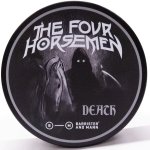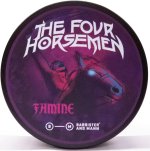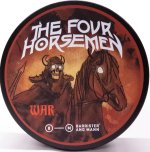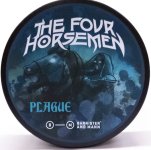The Shaving Cadre
You are using an out of date browser. It may not display this or other websites correctly.
You should upgrade or use an alternative browser.
You should upgrade or use an alternative browser.
New Barrister and Mann Releases
- Thread starter Scuttlesoap
- Start date
I've been trying to find info on these scents.For some reason, I thought of @Spider as soon as I saw these, as if Hallows was not dark enough from Barrister & Mann……Not a lot of details, the B&M site is down for revamping for this launch, but found it on Maggards…
View attachment 94877View attachment 94878
View attachment 94879View attachment 94880
I think Death is the common scent base and the other 3 layer something additional on that.
From some promotional email I got from them (which is replicated on the Maggard’s website):
“Everything is centered around a core accord, which represents Death. Logically, the other three horsemen are really just facets of Death, so there’s a certain thematic significance to offering War, Famine, and Plague as variations upon the ultimate end. A classic, mossy, resinous chypre (“sheep-ruh”), Death’s entire design is constructed around an elemental and timeless character that smells like it just came from the primordial ooze. This is the scent of an entity that was here before anything else, and will continue long after Everything™ is nothing but dust and ashes.
Plague is perhaps the most obvious of the set, constructed from a series of herbs built upon the chypre core and meant to recall the herbal poultices used by plague doctors in their famous beaked face masks to help prevent the transmission of “miasmas” that they believed caused disease. It was common for such individuals (it’s hard to call them “physicians” by any modern standard) to fill the beaks of their masks with lavender, thyme, sage, or other strong herbs and flowers, and we've elaboratde upon this idea a bit by incorporating not only those three plants, but rosemary and geranium as well in order to tame what was seen as the beneficial pungency of the herbs.
Famine is, like the rest of its kin, is a sort of fragrance overlay built upon the core accord. Specifically designed to recall aromas of dust and desiccation, it incorporates a peculiar series of materials, particularly the aroma chemical Norlimbanol, which is frequently used to dry out masculine fragrances and give them the strangely spiky tang that one might associate with chemical desiccants or dry ice. Famine is our favorite of the four, both for its artwork and for the construction of the fragrance, and we’re really looking forward to getting it out for people to smell.
War: Encapsulating the scent of a battlefield is a difficult and baroque idea, and it’s important to not venture too far down the proverbial rabbit hole so that we avoid incorporating the smell of artillery victims and human suffering in any kind of realistic format. Spoiler: we did not do that. But we’ve instead attempted to represent the aromas of hot metal and gunpowder, which we so thoroughly associate with the last four to five hundred years of warfare, through the use of two separate accords that I designed for the purpose. To avoid the fragrance reeking of burned propellant, we’ve kept the gunpowder note quite light, but the strange, ethereally ozonic note of hot metal is here in full force, offering a clean-but-unsettling cast to the fragrance. One thing is for certain: you will never mistake War for anything else.”
From some promotional email I got from them (which is replicated on the Maggard’s website):
“Everything is centered around a core accord, which represents Death. Logically, the other three horsemen are really just facets of Death, so there’s a certain thematic significance to offering War, Famine, and Plague as variations upon the ultimate end. A classic, mossy, resinous chypre (“sheep-ruh”), Death’s entire design is constructed around an elemental and timeless character that smells like it just came from the primordial ooze. This is the scent of an entity that was here before anything else, and will continue long after Everything™ is nothing but dust and ashes.
Plague is perhaps the most obvious of the set, constructed from a series of herbs built upon the chypre core and meant to recall the herbal poultices used by plague doctors in their famous beaked face masks to help prevent the transmission of “miasmas” that they believed caused disease. It was common for such individuals (it’s hard to call them “physicians” by any modern standard) to fill the beaks of their masks with lavender, thyme, sage, or other strong herbs and flowers, and we've elaboratde upon this idea a bit by incorporating not only those three plants, but rosemary and geranium as well in order to tame what was seen as the beneficial pungency of the herbs.
Famine is, like the rest of its kin, is a sort of fragrance overlay built upon the core accord. Specifically designed to recall aromas of dust and desiccation, it incorporates a peculiar series of materials, particularly the aroma chemical Norlimbanol, which is frequently used to dry out masculine fragrances and give them the strangely spiky tang that one might associate with chemical desiccants or dry ice. Famine is our favorite of the four, both for its artwork and for the construction of the fragrance, and we’re really looking forward to getting it out for people to smell.
War: Encapsulating the scent of a battlefield is a difficult and baroque idea, and it’s important to not venture too far down the proverbial rabbit hole so that we avoid incorporating the smell of artillery victims and human suffering in any kind of realistic format. Spoiler: we did not do that. But we’ve instead attempted to represent the aromas of hot metal and gunpowder, which we so thoroughly associate with the last four to five hundred years of warfare, through the use of two separate accords that I designed for the purpose. To avoid the fragrance reeking of burned propellant, we’ve kept the gunpowder note quite light, but the strange, ethereally ozonic note of hot metal is here in full force, offering a clean-but-unsettling cast to the fragrance. One thing is for certain: you will never mistake War for anything else.”
The descriptions in Maggards gives some details but you have to parse it from the other descriptives…..Ooops spoke too soon @EMG06 to the rescue!I've been trying to find info on these scents.
I’m holding out for “Trench Foot”.
I have Death but haven’t used it yet… looking forward to giving it a try soon. Also, looking forward to a few of the next seasonal releases, Vespers, later this month and Fougere Classique, early December.




